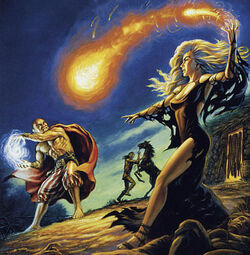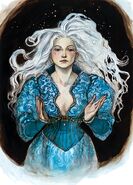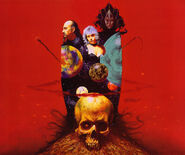The Simbul, born Alassra Shentrantra Silverhand, and also known as the Witch-Queen, was one of the Seven Sisters, a Chosen of Mystra, a ruler of Aglarond, and one of the most powerful spellcasters in Faerûn.[1]
Description[]
The Simbul was heedless of her personal appearance, with her hair always being a wild, tangled mess. She usually wore only a tattered black robe and appeared adventurer-booted or barefoot.[9]
She was capable of shapechanging at will and often took the form of a black raven.[9]
Personality[]
She had a reputation as a wild and powerful sorceress, highly unpredictable and prone to sudden outbursts of rage. Many of her subjects feared her as much as they respected her for her recklessness and apparent unstable nature.[1]
Relationships[]
Being one of the Seven Sisters, the Simbul was the daughter of Dornal Silverhand and Elué Shundar.[6]
She was a lover of the Sage of Shadowdale, Elminster. Elminster's love helped reduce the frequency of her berserker rage fits, but she was still feared for the amount of damage she could inflict.[1]
King Azoun IV of Cormyr once called her "a good friend, but a deadly enemy".[1]
The Simbul was protected by a personal guard called the Simbulmyn, commanded by High Captain Hovor Seawind circa 1372 DR.[10]
Apprentices[]
As of 1372 DR, the Simbul had four female human apprentices: Evenyl Nathtalond, a wizard and sorcerer; Phaeldara, also a wizard and sorcerer; The Masked One, a sorcerer and rogue; and Thorneira Thalance, a sorcerer and wizard.[10] At some point before 1362 DR, one of her apprentices was Brenna Graycloak, a council member of Aglarond and a Harper.[11]
Successor[]
It was rumored that the Simbul had written a document that named her successor and that the document was in the hands of the Harpers, believed to be with either Elminster or Khelben "Blackstaff" Arunsun.[12]
Enemies[]
The Simbul had earned the particular enmity of the Red Wizard Velsharoon, before his apotheosis to demigodhood in 1368 DR.[13][14]
History[]
Born on Eleasis 13,[15] 776 DR, after the death of her mother a year after, young Alassra was entrusted by Mystra, the Goddess of Magic, to the care of Oraumae, a witch of Rashemen. Mystra gave the witches spells that enabled them to rule Rashemen and repel invasions by Thay.[16]
After the Simbul left the witches, she started wandering the planes. Little was known about her whereabouts during that period, which lasted for some 400 years. It was said that Mystra herself revealed to her the fact that she was one of the Chosen of Mystra, after one of her consorts (allegedly a wizard from another plane) perished.[17]

The symbol of the Simbul.
The Simbul ended up posing as the apprentice of Ilione, a lesser sorceress and ruler of Aglarond. In the Year of Burning Steel, 1246 DR, the wizard Elminster recognized the Simbul for whom she really was.[17] She took the name "the Simbul" from a deity of the primitive human tribes that inhabited the Yuirwood before the elves moved there, and whose runes could still be found deep within the wood (the goddess known as the Simbul had been absorbed as an aspect of Labelas Enoreth).[18]
Ilione designated the Simbul as her successor and she assumed the throne of Aglarond upon Ilione's death in the Year of the Watching Cold, 1320 DR.[1]
In Mirtul of the Year of the Worm, 1356 DR, the Simbul vanished from her court, leaving a letter addressed to her councilors with instructions for how to rule wisely in her absence. It was speculated that she had snuck away while polymorphed as a cat or falcon in order to keep tabs on her enemies and/or her uneasy allies.[19]
The esteemed researcher, traveler, and writer Volothamp Geddarm angered many of Faerûn's mages in the Year of the Serpent, 1359 DR when he published the infamous Volo's Guide to All Things Magical. Wizards felt that Volo exposed their secrets via the book and actively sought to punish the man. However, the Simbul was quite amused by the commotion caused by the hapless bard and only transformed Volo into a bird and made him fly into a wall as a punishment. The Witch-Queen dispensed some other magical chastisement on the writer, yet in the end, she gifted him an enchanted etched stone with a sly smile. The Simbul told Volo in a soft voice that his survival might depend on the stone's magic. She also warned the man that were he ever foolish enough to anger every spellcaster on Toril, no trinket would be enough to save his hide.[20]
It was the Simbul whom Mystra sent into Avernus, the first layer of Baator, to retrieve Elminster when he was trapped there in the Year of Wild Magic, 1372 DR.[21]
The Simbul was widely believed to have been consumed in the fire that destroyed the deity Velsharoon in the Year of Seven Sisters, 1425 DR. In reality, however, she survived.[22]
Following the collapse of the Weave in the Spellplague after 1385 DR, Alassra had been driven mad. The only thing able to return her sanity was the consumption of the magic in enchanted items, which Elminster and Storm brought to her whenever they could. Aside from these brief respites from insanity, the Simbul would transform into some wild creature, usually a raptor of some sort, hunting wild game and eating it raw. She would return to only a few familiar spots—the ruins of Tethgard and a cave near Storm's farm being two. The latter was set up specifically for Alassra by Elminster and those Chosen of Mystra that survived the Spellplague and could still perform magic. They placed a number of wards at the front of the cave that would terrify would-be intruders, and at the back enchanted a set of manacles that would give the Simbul comfort while keeping her restrained near an ever-full pool of water. She could survive there indefinitely, feeding not on food but on the magic of the wards—slowly draining them—and the water from the pool.[23]
In the Year of the Ageless One, 1479 DR, Elminster and Storm restored the Simbul's sanity by feeding her a blueflame item. After her mind was restored, she charged both Elminster and Manshoon to work to gather all the blueflame items together, possibly to restore Mystra.[24]
She started to travel through the Realms, closing dimensional rifts created after the Weave collapsed during the Spellplague, aided by the power of the blueflame items and Mystra's guidance. In one of the rifts, she was ambushed by a horde of demons and almost dismembered, but she managed to prevail by absorbing the power of Blueflame items into herself, destroying the demons and the rift but transforming herself into a being of pure silver fire. After that, she traveled to Suzail to help her lover and arrived just in time to prevent Elminster from being killed by a group of Cormyr's War Wizards, who wrongly believed that he was an enemy. In order to heal Elminster, she sacrificed herself by restoring the Old Sage into his original body and giving him her silver fire, causing Alassra's body and soul to dissipate into nothingness.[5]
Trivia[]
As well as signifying Alassra Silverhand's connection to Aglarond through its deific origins, the word simbul meant "watchful warrior-wizard" in the ancient Aglarondan language, and Alassra lived up to that role.[25]
Reputation[]

Simbul, in the midst of a spell-slinging duel.
The tale that had made the Simbul's power (and temper) famous throughout Faerûn was that of her single-handed destruction of the Red Sword, a company of 2,000 mercenaries who refused to parlay with her.[19][26][27]
Her presence alone was a strong incentive for the Red Wizards of Thay not to attack Aglarond. When she committed herself to battle, the amount of damage she could cause was incredible. She sometimes made her enemies an example, using far more magic than necessary to destroy them in a spectacular fashion. No Red Wizard in his right mind would have faced the Simbul, and even her own subjects in Aglarond sometimes feared and avoided her, thinking her mad.[1][25]
The Simbul was also a creator of a number of enchanted items. One such creation, reportedly, were the maps of location, simple rolls of parchment, that, when in sea, could be unrolled and display the map and position of the map user's ship. Simbul's maps of location were invaluable tools used by Aglarondan navy.[28]
Appendix[]
| This article is incomplete. You can help the Forgotten Realms Wiki by providing more information. |
Gallery[]
Appearances[]
Novels & Short Stories
Video Games
Neverwinter Nights 2: Storm of Zehir
Organized Play & Licensed Adventures
Scrutiny on the Bounty
References[]
- ↑ 1.0 1.1 1.2 1.3 1.4 1.5 1.6 1.7 1.8 1.9 Ed Greenwood, Sean K. Reynolds, Skip Williams, Rob Heinsoo (June 2001). Forgotten Realms Campaign Setting 3rd edition. (Wizards of the Coast), pp. 200–201. ISBN 0-7869-1836-5.
- ↑ Ed Greenwood (August 1999). “The Haunting of Blandras Nuin”. Silverfall (TSR, Inc.), p. 257. ISBN 0-7869-1365-7.
- ↑ Ed Greenwood (1995). The Seven Sisters. (TSR, Inc), p. 36. ISBN 0-7869-0118-7.
- ↑ 4.0 4.1 Richard Baker, Matt Forbeck, Sean K. Reynolds (May 2003). Unapproachable East. (Wizards of the Coast), p. 112. ISBN 0-7869-2881-6.
- ↑ 5.0 5.1 Ed Greenwood (September 4, 2012). Elminster Enraged (Kindle ed.). (Wizards of the Coast), loc. 4958. ISBN 0786960299.
- ↑ 6.0 6.1 Ed Greenwood, Sean K. Reynolds, Skip Williams, Rob Heinsoo (June 2001). Forgotten Realms Campaign Setting 3rd edition. (Wizards of the Coast), p. 280. ISBN 0-7869-1836-5.
- ↑ Ed Greenwood (1995). The Seven Sisters. (TSR, Inc), p. 35. ISBN 0-7869-0118-7.
- ↑ Andy Collins, Bruce R. Cordell (July 2002). Epic Level Handbook. (Wizards of the Coast), pp. 296–297. ISBN 0-7869-2658-9.
- ↑ 9.0 9.1 Ed Greenwood, Sean K. Reynolds, Skip Williams, Rob Heinsoo (June 2001). Forgotten Realms Campaign Setting 3rd edition. (Wizards of the Coast), p. 201. ISBN 0-7869-1836-5.
- ↑ 10.0 10.1 Richard Baker, Matt Forbeck, Sean K. Reynolds (May 2003). Unapproachable East. (Wizards of the Coast), p. 111. ISBN 0-7869-2881-6.
- ↑ Dale Donovan, Paul Culotta (August 1996). Heroes' Lorebook. (TSR, Inc), p. 23. ISBN 0-7869-0412-7.
- ↑ Anthony Pryor (June 1995). “Campaign Guide”. In Michele Carter, Doug Stewart eds. Spellbound (TSR, Inc.), p. 51. ISBN 978-0786901395.
- ↑ Ed Greenwood (1991). Halls of the High King. (TSR, Inc), p. 64.
- ↑ Eric L. Boyd (September 1997). Powers & Pantheons. Edited by Julia Martin. (TSR, Inc.), p. 76. ISBN 978-0786906574.
- ↑ Lynn Abbey (1997). The Simbul's Gift. (TSR, Inc). ISBN 0-7869-0763-0.
- ↑ Ed Greenwood (1995). The Seven Sisters. (TSR, Inc), p. 8. ISBN 0-7869-0118-7.
- ↑ 17.0 17.1 Ed Greenwood (1995). The Seven Sisters. (TSR, Inc), p. 9. ISBN 0-7869-0118-7.
- ↑ Eric L. Boyd (November 1998). Demihuman Deities. Edited by Julia Martin. (TSR, Inc.), p. 117. ISBN 0-7869-1239-1.
- ↑ 19.0 19.1 Ed Greenwood, Jeff Grubb (August 1987). “DM's Sourcebook of the Realms”. In Karen S. Martin ed. Forgotten Realms Campaign Set (TSR, Inc.), p. 37. ISBN 0-88038-472-7.
- ↑ Obsidian Entertainment (November 2008). Designed by Tony Evans. Neverwinter Nights 2: Storm of Zehir. Atari.
- ↑ Ed Greenwood (June 2002). Elminster in Hell. (Wizards of the Coast), p. ?. ISBN 0-7869-2746-1.
- ↑ Bruce R. Cordell, Ed Greenwood, Chris Sims (August 2008). Forgotten Realms Campaign Guide. Edited by Jennifer Clarke Wilkes, et al. (Wizards of the Coast), p. 88. ISBN 978-0-7869-4924-3.
- ↑ Ed Greenwood (June 2011). Elminster Must Die (Mass Market Paperback). (Wizards of the Coast). ISBN 978-0786957996.
- ↑ Ed Greenwood (2011). Bury Elminster Deep. (Wizards of the Coast). ISBN 0786958154.
- ↑ 25.0 25.1 Ed Greenwood (1995). The Seven Sisters. (TSR, Inc), p. 34. ISBN 0-7869-0118-7.
- ↑ Ed Greenwood (1995). The Seven Sisters. (TSR, Inc), p. 119. ISBN 0-7869-0118-7.
- ↑ Steve Perrin (1988). Dreams of the Red Wizards. (TSR, Inc), p. 63. ISBN 0-88038-615-0.
- ↑ Template:Cite organized play/LC/Scrutiny on the Bounty




